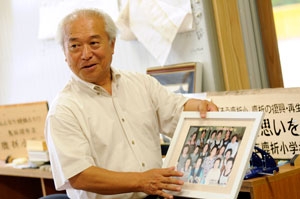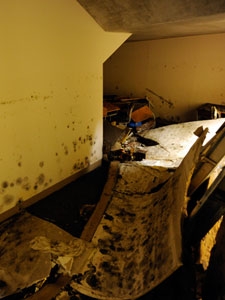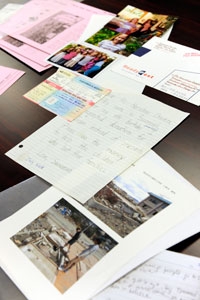Six Months on: Disaster Preparedness and Living Life to the Full
- Japan Diary 4 by Francis Markus in Kesennuma -
2011/09/27

Norishige Onodera, the principal of Shishiori Primary School is a chatty, jokey character in his late 50’s. But when he takes us out to the balcony of his school to show us where the Tsunami came in from, he suddenly becomes a different, much quieter man.
“It came from over there,” he says, indicating the river just a hundred meters or so away from where we are standing. “After the earthquake, the parents all came to pick up their children from the school, but one grandfather came for his three grandchildren and the tsunami hit their car and they were all killed.”
So now, Mr Onodera tells the children that a) they should not forget about the disaster and those who helped them through it and b) they should live life to the full, living a bit extra to make up for the three who died.
(Photo: School principal Norishige Onodera, shows a photo of Red Cross Volunteer group who brought relief items. He has received more than 300 visitors to cheer the school up. (c) Nobuyuki Kobayashi )

He says he himself tried not to think about the traumatic events of March 11 and distract himself -- until one day, he met a family from nearby, who were on their way to the morgue to search for a missing relative. “They had been going there every day. That made me realise that I should not try to put the disaster out of my mind, because whatever we do, it is still present.”
From what I can see, at least that lesson seems to be being put into practice. On the floor in one second floor room, a poster-sized piece of summer vacation homework sets out one student’s thoughts about what is important in earthquake preparedness: things like discussing an evacuation point for the whole family and preparing a survival kit full of useful things you need if evacuated.
The school itself is now better equipped than before the disaster at least in terms of its clinic. Along with more than 60 other schools in the prefecture, Japanese Red Cross Society has donated new equipment for the school clinic.
(Photo: The children escaped to the playground right after the eartthquake and climbed up the hill behind the school. The tsunami came 20 minutes later and swept away everything on the first floor. (c) Nobuyuki Kobayashi )

But does Mr Onodera -- a man who survived a tsunami in this part of Japan caused by the 1960 earthquake in Chile, when he was a pupil in this school himself -- think that enough is being done in disaster preparedness?
Not necessarily, is the answer. For a start, he says, it would be much better if the school had been relocated -- when it was rebuilt last year -- on higher ground, like a nearby junior high school. But that option was rejected because of lack of suitable land.
Also, he says, “even when there was a tsunami warning recently, many people rushed to stand by the river and watch for the tsunami, instead of evacuating to higher ground.”
It was a case of crying wolf. “When there was a tsunami warning and none came, then the next time people didn’t take the warning seriously.”
(Photo: Kids in 5th grade are very energetic and lively. The Principal says “I could not have lived through the first 3 months after the disaster if I wasn’t with them.” (c) Nobuyuki Kobayashi )

Japan has long had a reputation as one of the most disaster-prepared countries. But judging from Mr Onodera’s comments, there is still more that can be done.
And that reminds me of a discussion I had before leaving Tokyo for the disaster area. Because if this is true for the earthquake and tsunami, according to JRCS President Tadateru Konoe, it’s even more true of the Fukushima nuclear accident.
“The fact is that nuclear plants were believed to be safe in Japan, but that is not the case, so wherever nuclear plants exist, we have to be prepared for any eventuality or accident. From there we can start analysing different possibilities and scenarios for preparation and addressing any potential accident,” he says.
(Photo: Letters and donations came not only from Japan, but from all over the world. (c) Nobuyuki Kobayashi )















